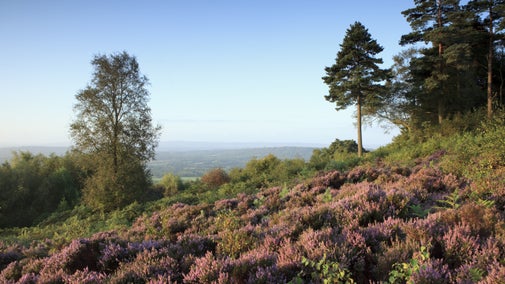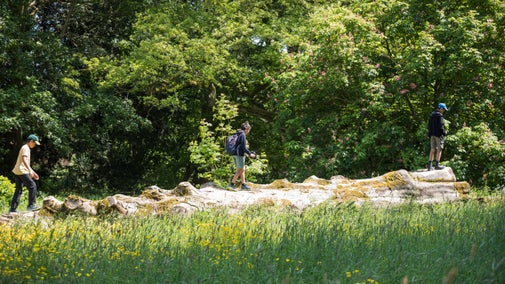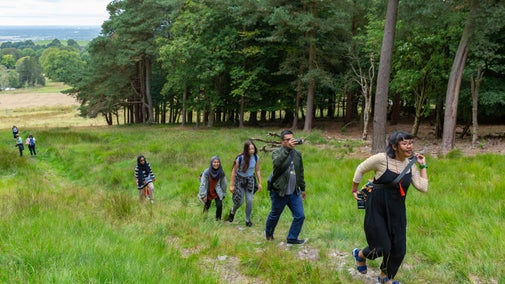
Discover more at Swan Barn Farm
Find out how to get to Swan Barn Farm, where to park, the things to see and do and more.

At Swan Barn Farm, on the Surrey-Sussex border, the changing landscape throughout the seasons provides much to see and do, ensuring that one visit is never quite enough. Throughout the year different flora and fauna come into life, animals can be spotted, and food can be foraged. All of this can be enjoyed from numerous dog-friendly walking trails.
You're welcome to stroll along the footpaths, recharging your batteries in the fresh air. You could even have a picnic if the weather is on your side.
The working pastures at Swan Barn Farm are grazed and cut for hay, which increases their biodiversity, and so there are many wild flowers, flora and fauna to be found.
In summer, the sweet scent of dog rose fills the air as it winds through the hedges. In winter, why not enjoy winter walks made firm of foot under the bright night frosts?
The Serpent Trail starts here - a 64-mile walking trail designed to showcase some of the finest views and countryside in the area.

The woodlands at Swan Barn Farm are characterised by mature oak with different aged copses of sweet chestnut and hazel.
Autumn is a particularly fruitful season to explore this habitat, as the trees all put on their mantels and light up the paths in a crackling auburn glow.
Towards winter, traditional coppicing starts in the woodlands, with fogged breath, the sound of the saw and the crack of a fire all drifting on the still crisp air.
The chestnut and hazel coppices are cut on rotation, producing fencing and building materials which are used in the local area.
With the land located so close to Haslemere high street, these woodlands are also a retreat for wildlife. They're rich with birds, moths and mammals, including an array of specialist species such as dormice and nightingales.
You're very welcome to walk your dog at Swan Barn Farm, and there are lots of footpaths for you and your furry friend to explore. You can enjoy a walk in the woodland and pasture at any time of year.
We’ve worked with our partner Forthglade to come up with this Canine Code, which helps to make sure everyone can enjoy their day:
Take a walk through the orchards, one of which is over 100 years old. The team have been restoring it over many years, including planting traditional varieties of fruit.
The newer orchard was planted in 2010 and has a mix of old and new varieties. As tempting as it may be, please resist trying an apple in this orchard as our trees are young and still growing.
We have over 35 varieties of apples in total. Team favourites include Court Pendu Plat, Cornish Gilliflower (an old Truro native), Newton cooking apples – named after the mathematician himself – and Tom Putt for cider making.
In autumn, watch out for small mammals hiding their ripe autumn bounty to tide them over the cold winter months.

No matter the time of year there’s always something to forage from Swan Barn Farm.
Early on you’ll find nettle tips for tasty soups and beer, before succulent blackberries and crisp apples ripen in late summer, providing a seasonal treat for nocturnal badgers and tipsy red admiral butterflies that gorge on fallen fruit.
The autumn months see a bounty of hazelnuts, chestnuts and a host of fungi, while even the winter yields sloes for a warming tot of sloe gin.
A hungry herd of Sussex cattle often graze the fields to ensure the pastures stay rich in flowers and scrub doesn't take over. In the orchard, South Downs sheep - a traditional breed for the area - are brought in to manage the grassland.
Look out for birds while visiting Swan Barn Farm. In late spring, chiffchaffs add their voices to the the dawn chorus joining blackbirds, robins and song thrushes in their early morning song. The trees provide food and shelter for a wide range of species including nuthatch and greater spotted woodpecker.
In winter, the team will start checking for brown hairstreak butterfly eggs, searching in the nooks and crannies of the bare hedgerow twigs.
As spring comes around, watch out for orange-tip butterflies around the delicate pink of the lady's smock flowers.
In the summer, the pastures buzz with insects like the fast-flying golden-ringed dragonfly, the second largest to the emperor dragonfly.
Below the cool green dappled canopy and along the winding stream you’ll see them hawking up and down the river in search of food.

Find out how to get to Swan Barn Farm, where to park, the things to see and do and more.
Surrey Hills is a one pawprint rated place. With a wide variety of paths and open spaces, the Surrey Hills are an ideal place to bring your dog for a walk. Here’s what to keep in mind to keep your dog and others safe.

Find out how and why we have been coppicing woodland at Witley Copse, and more about the practice itself, in particular the benefits it holds for both plants and wildlife.

The highest point in the South Downs National Park

Coconut-scents, purple heather and intimate woodland walks

Plan a visit to one of the special countryside places in our care and discover the benefits of being in the great outdoors. Pack your walking boots and get ready to explore woodlands, valleys and rivers.

Explore the wide array of countryside settings around Surrey, from tranquil waterways to landscaped parkland, and plenty of hills to climb.

Explore some of the finest landscapes in our care on coastal paths, accessible trails, woodland walks and everything in between. Find the best places to walk near you.
